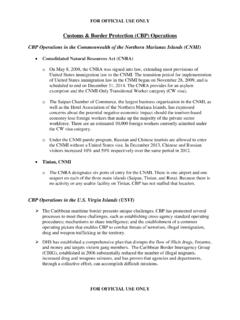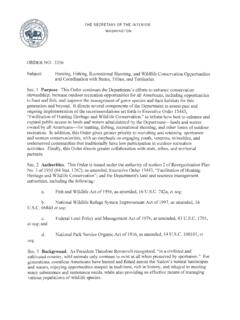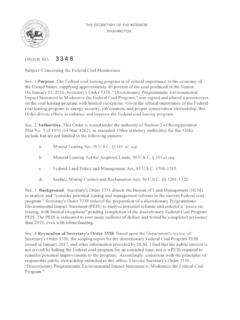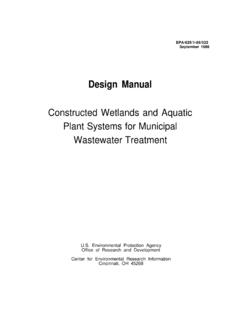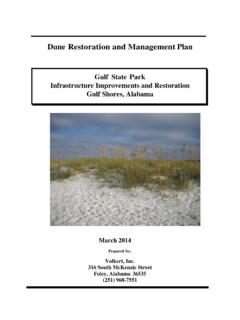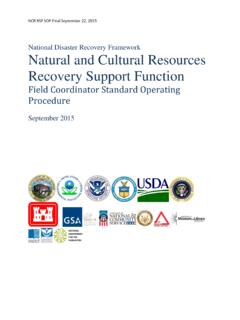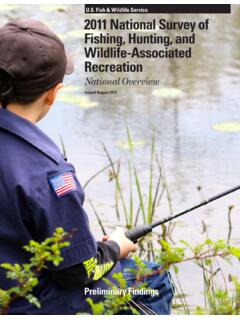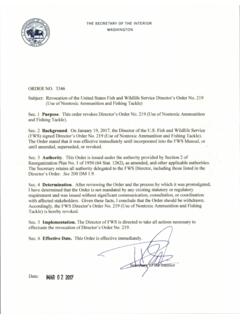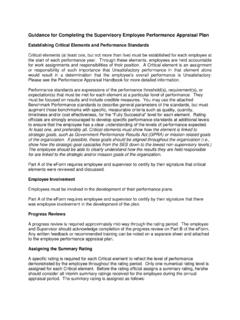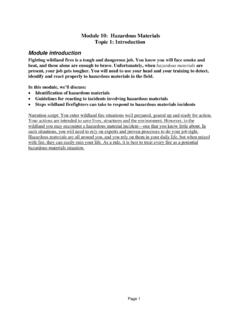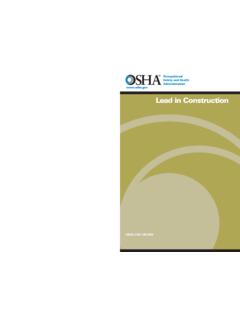Transcription of COVID-19 Preparedness and Response Supervisor’s Guide
1 Department of the Interior COVID-19 Preparedness and Response Supervisor s Guide Version March 11, 2020 SDEPARTMEUMARCH3,1849 TNTHEINTERIORD epartment of the Interior COVID-19 Preparedness and Response Supervisor s Guide March 2020 i Record of Changes Change No. Description of Change Date Posted by Department of the Interior COVID-19 Preparedness and Response Supervisor s Guide March 2020 ii Approval The Supervisor s Guide to Preparedness and Response for COVID-19 is based on the Government COVID-19 Response Plan and the DOI Pandemic Influenza Plan (DOI Pandemic Plan) to provide prevention and mitigation actions that supervisors can use to develop a unit specific plan of action to: Protect the health and safety of DOI s employees. Maintain and ensure the continuation of the mission essential functions of the Department as a part of continuity planning.
2 Support the Federal, State, Tribal, Territorial, and local Response . Communicate effectively with DOI s stakeholders during a public health emergency related to COVID-19 . Approved by: Gregory Shelton, Acting Director, Office of Emergency Management _____ Department of the Interior Supervisor s Guide to Preparedness and Response for COVID-19 March 2020 iii Contents Record of Changes .. i Background .. 1 Risk Assessment .. 1 Purpose .. 1 Planning Assumptions .. 2 Planning and Preparedness .. 2 Mitigation Strategies to Employ for COVID-19 .. 3 Operationalizing Mitigation Strategies .. 4 DOI Activation Triggers for Mitigation Strategies .. 7 Appendix A Risk Assessment and Public Health Management Decision Making Matrix . 1 Appendix B: HR Flexibilities .. 1 Appendix C: Maintaining a Healthy Work Environment .. 1 Appendix D: Other Employee Resources .. 1 Department of the Interior Supervisor s Guide to Preparedness and Response for COVID-19 March 2020 1 Background Outbreaks of novel virus infections among people are always of public health concern.
3 The risk to the general public from these outbreaks depends on characteristics of the virus, including how well it spreads between people; the severity of resulting illness; and the medical or other measures available to control the impact of the virus (for example, vaccines or medications that can treat the illness). The virus has been named SARS-CoV-2 and the disease it causes has been named coronavirus disease 2019 (abbreviated COVID-19 ). Risk Assessment COVID-19 is in the same family as other human coronavirus that have caused global outbreaks such as Severe Acute Respiratory Syndrome (SARS) and Middle East Respiratory Syndrome (MERS). Coronavirus causes respiratory tract illnesses which can lead to pneumonia, and in severe cases death. Known transmission routes for Coronaviruses include sustained human-to human transmission via respiratory droplets produced when an infected person coughs or sneezes.
4 As with all novel and emerging infectious agents, it is possible that continued spread of the coronavirus could result in a pandemic. The complete clinical picture with regard to COVID-19 is not fully understood. Reported illnesses have ranged from mild symptoms to severe illness resulting in death. Current understanding about how the virus that causes COVID-19 spreads is mainly from person-to-person: between people who are in close contact with one another (within about 6 feet) and through respiratory droplets when an infected person coughs or sneezes. It may be possible that a person can get COVID-19 by touching a surface or object that has the virus on it and then touching their own mouth, nose, or possibly their eyes, but this is not thought to be the main way the virus spreads. Current risk assessment for COVID-19 : For the majority of people, the immediate risk of being exposed to the virus that causes COVID-19 is thought to be low.
5 There is not widespread circulation in most communities in the United States. People in places where ongoing community spread of the virus that causes COVID-19 has been reported are at elevated risk of exposure , with increase in risk dependent on the location. Healthcare workers caring for patients with COVID-19 are at elevated risk of exposure . Close contacts of persons with COVID-19 also are at elevated risk of exposure . Travelers returning from affected international locations where community spread is occurring also are at elevated risk of exposure , with increase in risk dependent on location. The Health and Human Services - Centers for Disease Control and Prevention (CDC) has developed guidance to help in the risk assessment and management of people with potential exposures to COVID-19 . Purpose The Supervisor s Guide to Preparedness and Response for COVID-19 is based on the Government COVID-19 Response Plan and the DOI Pandemic Influenza Plan (DOI Pandemic Department of the Interior Supervisor s Guide to Preparedness and Response for COVID-19 March 2020 2 Plan) to provide prevention and mitigation actions that supervisors can use to develop a unit specific plan of action to: Protect the health and safety of DOI s employees.
6 Maintain and ensure the continuation of the mission essential functions of the Department as a part of continuity planning. Support the Federal, State, Tribal, Territorial, and local Response . Communicate effectively with DOI s stakeholders during a public health emergency related to COVID-19 . Planning Assumptions In the absence of facts or verifiable data, planning assumptions represent information deemed true. They are necessary to facilitate planning development efforts. Assumptions set a baseline for planning purposes and do not preclude specific activities or decision points that will occur in Response to the COVID-19 outbreak. The following planning assumptions are provided to support Preparedness planning at the supervisory level: Universal susceptibility and exposure will significantly degrade the timelines and efficiency of Response efforts. As an emerging infectious disease the virus SARS-CoV-2 may continue to be transmitted in communities for an unknown amount of time, necessitating recurrent and changing planning assumptions.
7 Some persons will become infected but not develop clinically significant symptoms and these asymptomatic or minimally symptomatic individuals may be able to transmit infection and develop immunity to subsequent infection. Multiple geographically dispersed waves of illness (periods during which community outbreaks occur across the country) could occur with each wave lasting 2 - 3 months. Certain public health and community mitigation measures are also likely to increase absenteeism. Historically, the largest outbreaks have occurred in the fall and winter, but the seasonality of COVID-19 cannot be predicted with certainty at this time. Many employees can perform their work through telework. Managers and employees will follow the normal workers compensation claims processes and applicable safety and health reporting/notification procedures for any work-related exposures.
8 Planning and Preparedness All leadership to include supervisors/managers, are encouraged to understand the prevention and mitigation strategies that are available. Supervisors/managers should document these strategies to ensure the continuation of all essential functions should the COVID-19 outbreak necessitate further active protections for DOI employees, contractors, partners, and the public. Prior to a local government-declared public health emergency supervisors should: Department of the Interior Supervisor s Guide to Preparedness and Response for COVID-19 March 2020 3 Review the unit continuity of operations (COOP) plan if available. Establish a list of mission essential functions to be executed in the event of an event of increasing severity. Develop a list of the associated employees responsible for performing each office function. Create an inventory of essential records, databases, and systems needed to sustain operations, if necessary, including whether these records can be accessed electronically from a remote location ( , an employee s home or other alternate work site).
9 Develop a summary of office work functions that cannot be performed remotely ( physical security, law enforcement activities, and maintaining critical infrastructure). For functions that may be performed from remote locations, create a list of employees performing these functions with at least three levels of backup either locally or from other regions of the country. For functions that may be performed from remote locations, prepare an inventory of required equipment [ , Government Furnished Equipment (GFE) laptops, remote access, high-speed internet] needed to perform these functions. Where sufficient backups may not exist, compile a directory of employees capable of being cross-trained to perform a variety of functions. Develop an inventory of contracts and contractors that perform functions that must continue or be augmented in the event of a COVID-19 outbreak of Coronavirus exposure ( custodial services, health center staffing, etc.)
10 Develop a list of employees performing high and medium exposure risk occupations that might be required to wear personal protective equipment (PPE) and/or prioritization to receive medical countermeasures/anti-virals ( anti-viral medication). Mitigation Strategies to Employ for COVID-19 The DOI Pandemic Plan outlines multiple strategies (listed below) that may be implemented by the supervisor or be directed by DOI leadership to protect the health and safety of personnel and continue to meet the DOI mission within an environment impacted by a COVID-19 outbreak. These strategies can be implemented in conjunction with one another or independently based on the circumstances and the nature of the task being performed. Follow general COVID-19 communicable disease prevention actions per the CDC: o Wash hands often with soap and water for at least 20 seconds. If soap and water are not available, use an alcohol-based hand sanitizer (>60% alcohol).
